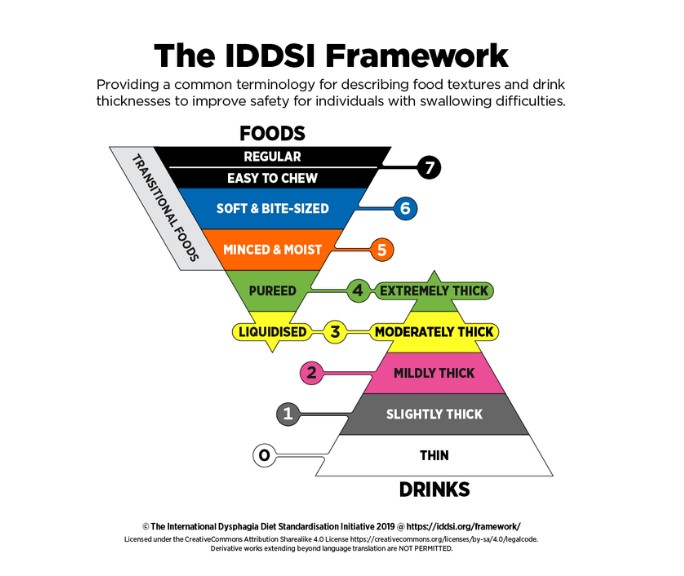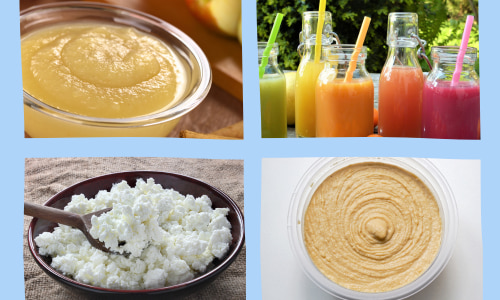Easy to Chew Foods for Elderly
“Easy to Chew Foods for Elderly” was written by Emily Reiser, RDN, LDN & edited/reviewed by Aly Bouzek, MS, RDN.
Foods that are easy to chew are a great way to maintain a liberalized diet while consuming foods that best match your diet texture needs.
Who Benefits from Easy to Chew Diets?
As we age, our dentition, or our ability to chew, often decreases. This can happen due to:
- loss of teeth
- poor dental status
- loss of muscle mass involved in chewing
- ill-fitting dentures
- etc.
Due to these factors involved with aging, foods that are easier to chew can be beneficial. Getting enough calories and nutrients are important. If easy to chew foods help your body get what it needs, then you’re in the right place!
Easy to chew foods contribute to decreased effort when consuming food items, and a smoother and more enjoyable meal experience overall.
Disclaimer: An easy to chew diet can be helpful for those with trouble chewing, though is not advised for those who have been identified as an increased risk of choking, have unsafe mealtime behaviors, or require supervision while eating.
If you have questions, consult your primary care provider regarding which diet textures are best suited for your needs.
IDSSI – A Framework for Diet Textures

IDSSI is the International Dysphagia Diet Standard Initiative who have created a framework, seen below, that describe food textures and liquid thicknesses needed based on someone’s ability to chew and swallow.
IDDSI – Easy to Chew Diet Texture
The easy to chew diet (level 7 as shown above) is the texture closest to a regular diet. The size of food items can vary, though they are often soft and tender in texture.
This texture level avoids hard, crunchy, and fibrous foods. This texture is soft though it still requires some chewing with teeth or gums. Easy to chew diet textures can have all the diet textures lower than (level 7) on the IDSSI scale.
This includes soft and bite sized (level 6), minced and moist (level 5) etc. If you feel that you may need a more modified or softer textures diet, then take a look at our comprehensive article on soft foods.
How to Test Foods for Easy to Chew Texture
The IDSSI framework has put together tests to assess the appropriateness of certain foods for an easy to chew diet. See below about how to conduct these tests.
Fork Pressure Test
Place a fork on the food item you are testing. Place your thumb on the fork just above the prongs of the fork. Press your thumb down on the fork until your thumb nail begins to blanch.
Once your thumb nail appears lighter, or blanched, the fork should be easily pressed through the food item. This amount of pressure from the thumb is very similar to the pressure the tongue provides when helping to chew foods.
If the fork is not easily able to push down on a food item, then the food item may not be soft enough for someone who has trouble chewing to eat.
This test can also be completed using a teaspoon, chopsticks, or fingers according to the most accessible testing method based on the country you are in.
Practice this test on a banana to get a sense of the soft texture.
Fork Separation Test
In addition to the fork pressure test, a fork separation test is can determine the tenderness of food.
Complete this test by using the side of a spoon, fork, or chopstick to break apart a food. If the food is easily separated by the utensil, then this indicates a soft texture that will likely break apart easily in the mouth while eating.
If the food item being tested compresses down rather than splitting, such as a piece of bread, or does not break apart easily, such as a hard piece of meat, then these foods do not pass the separation test.
Additionally, they could pose as a choking risk for someone who needs an easy to chew diet texture.
Easy to Chew Foods for Elderly
There are a wide variety of easy to chew foods to consume for meals, snacks, and desserts. See below for ideas to add a variety of easy to chew foods into your diet.
Easy to Chew Proteins
Serve meat as soft and tender, or as a minced/ground in texture with extra moisture. Serve fish as soft enough to easily break apart with the side of a fork, spoon, or chopsticks.
Some ideas for easy to chew proteins for elderly include:
- Ground meats (ground beef or ground chicken with gravy)
- Tender meats (meatloaf)
- Stewed meats (stewed chicken, turkey, or beef)
- Canned fish (tuna or salmon with mayonnaise)
- Tofu
- Scrambled eggs
- Greek yogurt
- Cottage cheese
Note: Adding gravy to meats can increase the tenderness and moistness of the protein – making it easier to chew and safer to eat.
Easy to Chew Vegetables
Steam or boil vegetables to cook to a more tender texture. Complete the fork pressure test to see if the vegetable being prepared has been cooked to the proper texture.
Some ideas of easy to chew vegetables for elderly include:
- Steamed or boiled broccoli
- Steamed carrots
- Steamed cauliflower
- Canned carrots
- Canned green beans
- Pureed vegetables
- Blended vegetable soup
East to Chew Fruits
Avoid the fibrous part of fruits, such as the skin of an apple, as this can be harder to chew. Cut fruit all the way through, with the side of a fork or spoon.
Some ideas of easy to chew fruits for elderly include:
- Bananas
- Peaches
- Plums
- Cooked fruits including apples
- Fruit juices
- Fruit cups (note: no pineapple)
- Canned fruits
Easy to Chew Starches
Starches are recommended to be easy to mash and chop through with a fork, spoon, or chopsticks. Adding a sauce or gravy can increase the moisture of the food item making the item easier to chew.
Avoid the fibrous portion of a starch, such as the skin of a potato, as this is harder to chew.
Some ideas of easy to chew starches for elderly include:
- Mashed potatoes
- Baked potato without skin – add butter/gravy for extra moisture
- Mashed sweet potatoes
- Softened rice
- Softened pasta
- Hot cereal
- Cereal in milk
- Pancakes
- Hash browns
Easy to Chew Snacks

For snacks, follow the same fork pressure and fork separation test as the food categories listed above.
Some snacks are listed below, though foods from other categories can be consumed as snacks as well.
Some ideas of easy to chew snacks for elderly include:
- Applesauce
- Yogurt
- Soft cheese
- Pate
- Hummus
- Smoothies
Easy to Chew Desserts
For desserts, follow the same fork pressure and fork separation test as the food categories noted above.
Some ideas of easy to chew desserts for elderly include:
- Ice cream
- Sherbet
- Gelatin
- Custard
- Pudding
- Moose
- Cake
- Italian ice
Easy to Chew Foods for Elderly: Foods to Avoid
There are a wide variety of foods that can be consumed on an easy to chew diet. However, there are also foods that are best avoided as they do not fall into the “easy to chew” category.
It is best to avoid foods that are very hard, or tough such as some cuts of meat. Avoid very chewy foods such as chewy candies that are not easily broken apart with the side of the fork.
Also, avoid highly fibrous or stringy textures that can cause trouble breaking apart such as the skin of fruits and vegetables. Additionally, it is best to avoid bones in meat and fish and pits in fruits to prevent choking risk.
Foods that should be avoided include:
- Tough meats
- Fruits and vegetables with skins
- Dried fruits
- Hard/raw fruits and vegetables
- Nuts
- Hard or sticky candies
- Pretzels, chips, or similar hard snack items
- Granola or cereal without milk
- Any foods that include hard chunks (yogurt with fruit pieces, ice cream topped with chocolate chunks)
A Note on Transitional Solids
A research study on age-related changes to eating and swallowing from the National Library of Medicine discussed transitional solids. These are foods which are initially dry/crunchy though melt/dissolve in your mouth with little chewing needed. (1)
This includes foods such as potato chips and wafers that, when paired with a high protein spread such as pate or hummus, could increase protein intake and provide a socially acceptable and easy to chew/swallow food option.
Easy to Chew Foods for Elderly Conclusion
As we’ve learned throughout the article, our ability to chew may change as we age. However, maintaining variety in our diet doesn’t have to.
Utilize the fork pressure test and fork separation test on the foods you are currently consuming to determine if they are easy to chew or not.
Use the foods listed above as well as other resources from the Geriatric Dietitian, such as 101 Soft Foods to Eat When Chewing Hurts, to incorporate new food items into your diet.
Best of luck on finding foods that work best for your dentition and health!
